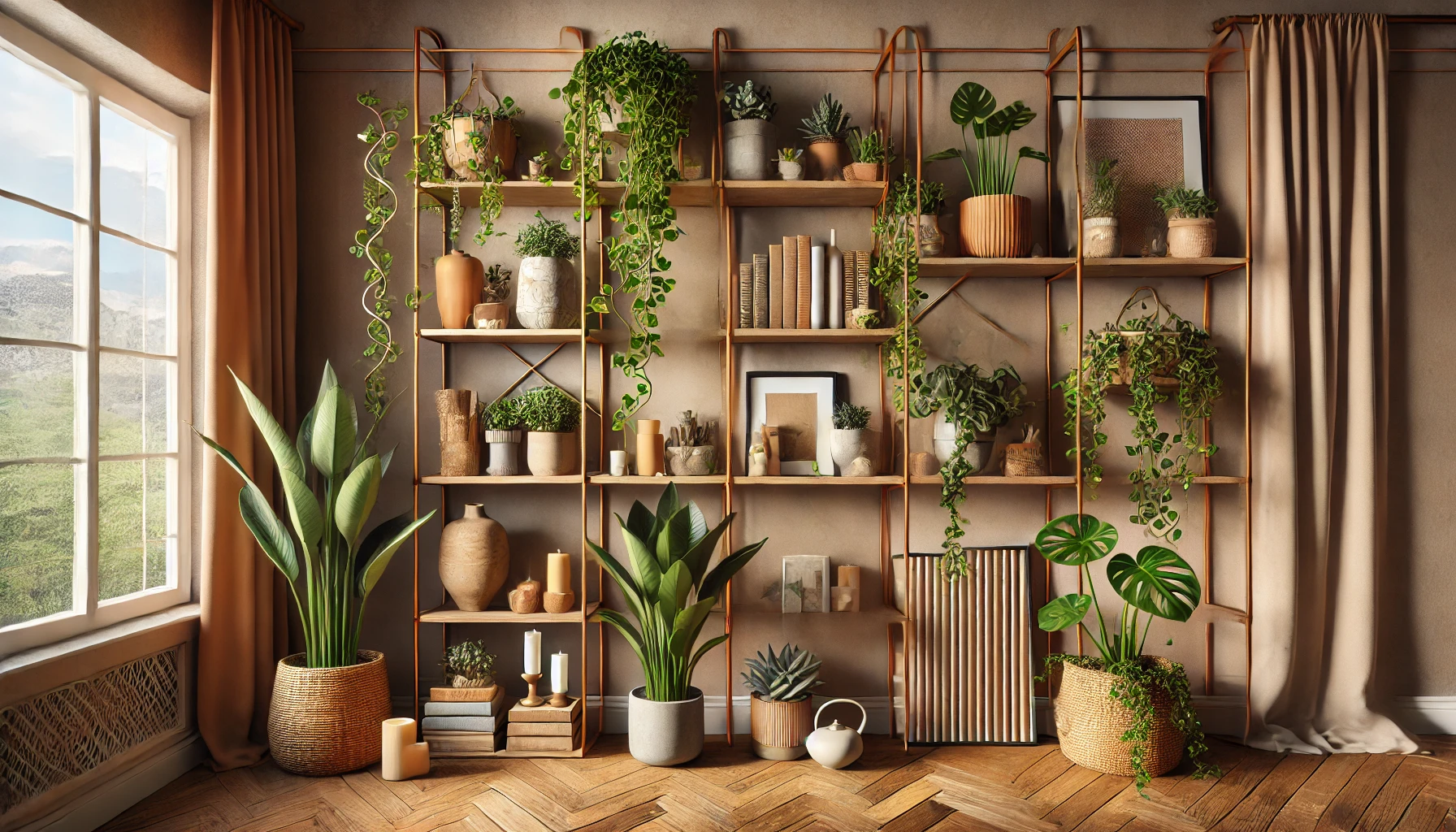Shelves aren’t just for books and framed photos — they’re also the perfect stage for your indoor plants. Whether you have a full bookshelf, floating shelves, or a small corner ledge, adding greenery can transform a space, bringing freshness, texture, and natural style into any room.
But creating a plant shelf that looks intentional — not cluttered — requires a bit of planning. In this guide, you’ll learn how to design a stylish, balanced, and thriving plant shelf display that fits your space and your vibe.
Why Use Shelves for Plant Displays?
Shelves are one of the most practical and versatile ways to add plants indoors. They allow you to:
- Maximize vertical space (great for small homes or apartments)
- Create visual interest at eye level
- Keep plants away from pets or kids
- Combine plants with decor for a more curated look
- Take advantage of available light near windows
With the right arrangement, your shelf becomes a living artwork.
Step 1: Choose the Right Location
Start by picking the best shelf or surface. Ideal spots for plant shelves:
- Near a window with bright, indirect light
- In corners that get some natural light
- Against white or neutral-colored walls (plants pop more!)
- Above a desk, bed, or sofa to frame the space
If your shelf gets low light, choose plants that thrive in those conditions, or consider adding a small grow light nearby.
Step 2: Pick the Right Plants
For shelf displays, you want a mix of shapes, sizes, and textures. Look for plants that don’t outgrow the space too quickly or drop too much debris.
Great shelf-friendly plants include:
- Pothos – trailing and easy-care
- String of Pearls or Hearts – delicate and dramatic hangers
- ZZ Plant – upright, sculptural, and low-maintenance
- Peperomia – compact and colorful
- Snake Plant (small varieties) – vertical and modern
- Fittonia (nerve plant) – great for lower shelves and shady spots
- Cacti and succulents – perfect for sun-drenched shelves
- Air plants (Tillandsia) – no soil needed, super versatile
Choose plants with different growth habits — some upright, some trailing, some short and bushy — to create visual balance.
Step 3: Mix Decorative Elements
Don’t limit your shelf to just plants. Combining greenery with decorative objects creates a more interesting and curated look.
Try adding:
- Books (stacked vertically or horizontally)
- Candles or diffusers
- Small sculptures or pottery
- Picture frames or artwork
- Crystals, vases, or natural elements like driftwood
The goal is to let the plants shine while complementing them with textures and tones that enhance the space.
Step 4: Use a Variety of Pots
Your choice of pots affects the entire vibe. You can go uniform or intentionally mix styles. Some ideas:
- Terracotta for a warm, earthy look
- Matte white ceramics for a clean, minimalist touch
- Woven baskets for a boho or rustic feel
- Bold, colorful pots for a playful or eclectic shelf
Tip: Keep your color palette cohesive — for example, neutral tones with pops of green and gold.
Step 5: Play with Height and Layering
A flat row of plants can look boring. Add depth and dimension by:
- Using books to raise some pots
- Stacking plants in front of or behind each other (just don’t block the light!)
- Hanging trailing plants from the edge of the shelf
- Placing taller plants on top shelves, and shorter ones on lower levels
You can even lean a mirror or piece of art behind the plants to reflect light and add interest.
Step 6: Balance is Everything
For a shelf to feel styled (not chaotic), aim for balance:
- Mix odd numbers of items (groups of 3 or 5 work well)
- Balance large and small objects across the shelf
- Use one or two trailing plants to soften sharp lines
- Leave some breathing room between clusters
You want your shelf to feel alive and layered, but not cluttered.
Step 7: Think About Light and Water
It’s easy to forget about plant care once they’re up on a shelf. Keep these tips in mind:
- Choose plants that match the light levels of the room
- Use a small watering can with a long spout for easier access
- Consider grouping plants with similar water needs together
- Turn pots every couple of weeks for even growth
- Dust the leaves and clean the shelf regularly
And remember: safety first — always secure shelves well to hold the weight of plants and pots.
Optional: Add Lighting for Drama
Want to highlight your plant shelf at night? Add soft accent lighting like:
- Battery-operated LED spotlights
- Fairy lights draped among plants
- A strip light beneath the shelf above
This adds a warm, cozy glow and puts your green display in the spotlight — literally.
Great Shelf Display Themes to Try
1. Urban Jungle: lots of greenery, macramé hangers, and layered textures
2. Modern Minimalist: white pots, clean lines, fewer plants but intentional placement
3. Boho Vibes: woven baskets, wood accents, trailing plants
4. Earth Tones: terracotta, stone, neutral greens and browns
5. Black & Green: dark shelving, bold contrast with bright green foliage
Choose a style that complements your home, or create your own theme with a personal twist.
Final Thoughts: Let Your Shelf Tell a Story
A well-styled plant shelf isn’t just decor — it’s a living display that grows with time. It reflects your personality, your creativity, and your connection with nature.
Don’t worry about getting it perfect on the first try. Rearrange, rotate, and experiment until it feels right. And above all, choose plants you love — the kind that bring you joy every time you walk past them.
Whether you have one shelf or five, let it become your own little vertical garden — a green escape, one leaf at a time.
